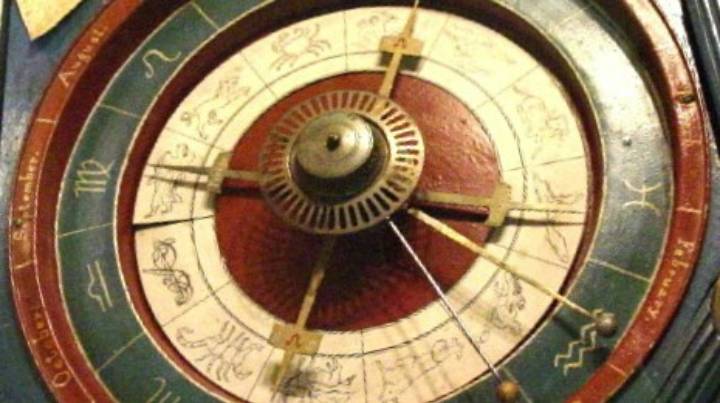
While the planets model shows the Earth orbiting the sun, this model shows the perspective from Earth: the sun circles the sky once per year as projected on the background of the stars. Botjes' description of this model is written out on the paper beside it. The sun is represented by the gold ball, and the months are labelled on the red rim. Inside the red rim are portrayed symbols and pictures of the twelve constellations of the Zodiac, placed in their ancient positions (for more on the Zodiac see the Orbits of the Planets).
The moon makes the same circle against the background of stars each sidereal month (27.32 days). This is marked by the counterclockwise revolution of the silver ball. The rate of motion is not uniform, however. As a consequence of the conservation of angular momentum, the moon moves 23% faster at perigee (closest approach to earth) than apogee (its furthest point from earth). The "line of apsides" pointer is labelled perigee on one end and apogee on the other, indicating the positions of these special points. The line of apsides rotates counterclockwise once in 8.9 years, due to the influence of the sun.
The phase of the moon is determined by the relative positions of the two balls: both together at new moon, both opposite at full moon, etc. The time between mutual alignments of the balls (29.53 days) is called the synodic month. Since 29.53 days does not divide evenly into the 365 days of the year, our own calendar long ago abandoned months that actually track with the moon. Other calendars take a different approach. The Jewish calendar uses twelve synodic months, plus a leap month every so often to keep the average length of the year on target. The Islamic calendar uses twelve synodic months exactly, with the consequence that the Islamic year is eleven days shorter than the solar year.
As the moon's orbit is tilted by five degrees with respect to the earth's orbit, the intersection of the two orbital planes defines a line called the line of nodes, which is marked by the pointer labeled "U". Eclipses can only occur when the moon is in the plane of the earth's orbit, and hence the silver ball is near one of the two ends of the line of nodes pointer. A solar eclipse occurs at new moon and a lunar eclipse at full moon. The line of nodes rotates clockwise one full circle every 18.6 years, due to the torque of the sun's gravity on the lunar orbit.
For a total solar eclipse to occur, the moon must also be near perigee. Otherwise the angular size of the lunar disk is too small to completely cover the sun, and an annulus of light surrounding the moon remains visible (an annular eclipse).






